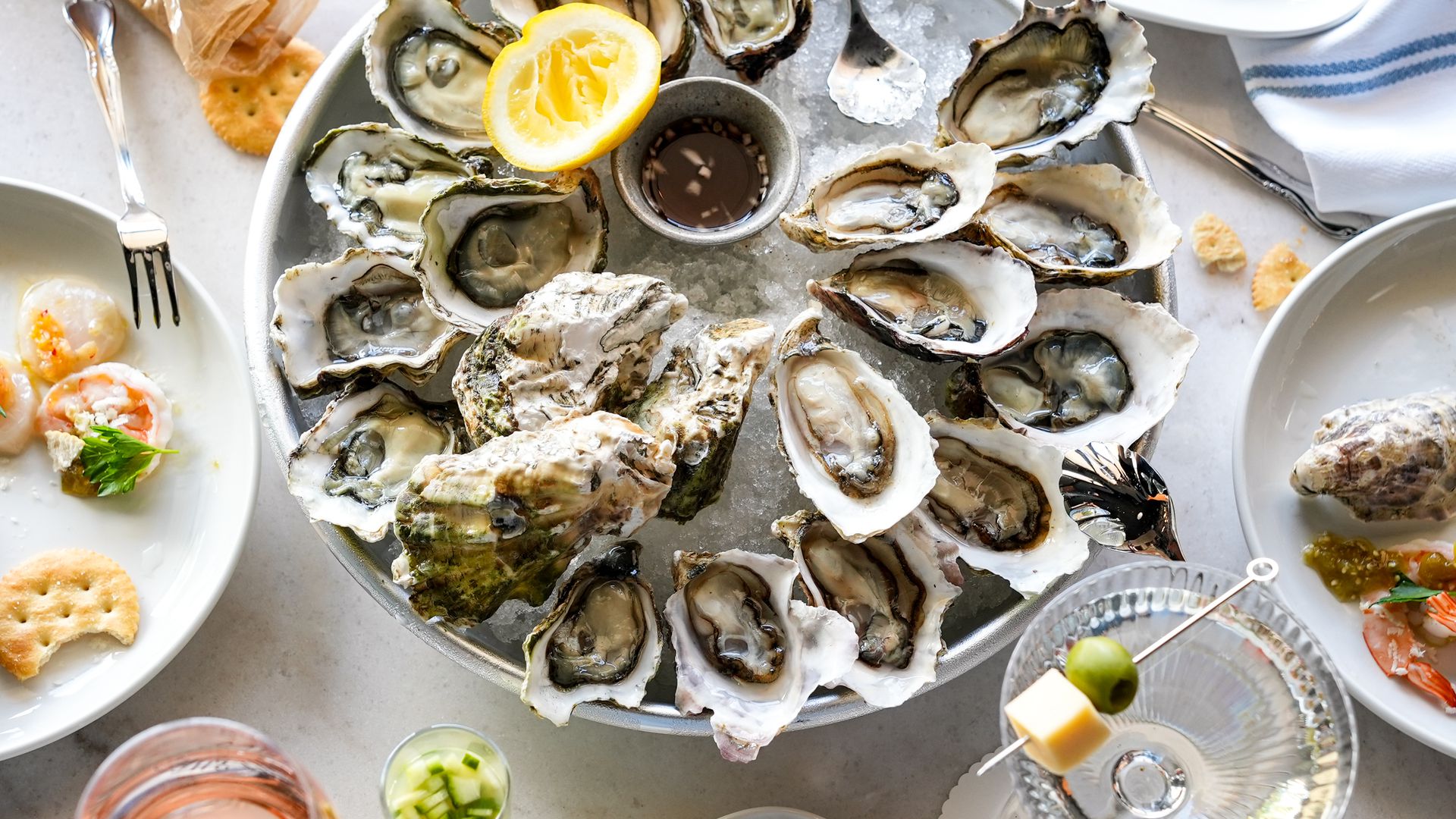
IS SEATTLE ABOUT TO ENTER A NEW OYSTER ERA?
In the past two decades, Seattle seafood houses established the prototype for the modern oyster bar: airy spaces with geoduck-length shellfish menus reminiscent of wine lists. At places like Elliot’s Oyster House and the Walrus and the Carpenter, guests can tour Puget Sound–area waterways through bivalve consumption and get a crash course in differing levels of brininess and flavor from knowledgeable servers.
The Garrison takes a slightly different approach. This is a moody, mussel-sized 17-seat bar and restaurant occupying the front room of the former Hotel Albatross on Ballard’s Market Street. Le Coin owners Josh Delgado and Jordan Melnikoff quietly opened it late last year, with Delgado developing a concise seafood-forward menu, including a simplified oyster selection primarily featuring Treasure Cove oysters from Emerald Acres Oysters.
But the smaller oyster selection at the Garrison doesn’t make it any less of an oyster bar; it’s about highlighting a purveyor and a product Delgado holds in high regard.
“Kevin (Riley) is an oyster farmer through and through,” Delgado says. “He spreads the seeds, he harvests himself, he bags them, delivers them himself… [And] he kind of blows your mind with oyster knowledge. What I like about his product is it’s a great representation of an actual naturalized Washington oyster.”
The Garrison is one of several recently opened oyster bars from experienced restaurateurs that eschew larger selections with “market price” listings and instead bring a sense of accessibility that’s uncommon for Seattle, without sacrificing anything about the experience.
When Brendan McGill (head of the Hitchcock restaurant group) opened Oyster Cellar in May, he introduced a more casual approach he said was inspired by Manhattan’s historic oyster bars. The restaurant’s long bar is fronted by chef Alex Jackson’s raw station, allowing diners a view of the chef making short work of shucking. It’s a setup that’s true to form for its old-school inspiration, as it creates an atmosphere of access between chef and diner that’s a hallmark of the classic oyster house — though Jackson’s banter is more affable than the sass that’s traditional back East. Like the Garrison, Oyster Cellar features a compact oyster selection and a definite reverence for the providers, which in this case is Baywater Shellfish Company and Jamestown Seafood.
“Our relationship with our farmers allows us to receive oysters the same day they come out of the water”’ says McGill over email. “Baywater Shellfish is based on Bainbridge Island, so I first met (founder) Joth Davis in the early days of Hitchcock. We’ve been buying oysters directly from them for 14 years… I love these oysters.”
At around the same time Oyster Cellar was opening, Tom Douglas Restaurants was bringing its Pike Place Market-adjacent Etta’s Big Mountain BBQ back to its seafood roots. Instead of returning the name to Etta’s Seafood, though, the company chose the oyster-evoking name Half Shell. And similarly to McGill, Douglas and chef/managing partner Eric Tanaka found inspiration in the oyster tradition of the eastern United States.
“Seattle is known more for seafood houses versus oyster bars,” Tanaka points out. “And I think when you go to New Orleans, there’s an oyster culture. I think back East, there’s an oyster culture. And I think bringing that more oyster-forward presence to the ambience of a Seattle fish house is really what we were shooting for.”
The idea is to see oysters as not so much a rarified, special occasion dish, and more of a essential, casual part of the city’s dining scene. But in order for that to be the case, the oysters have to be affordable, and the good news there is all three restaurants are running happy hours where a dozen oysters can be had for $24.
“I think people tend to think of oysters as being so precious,” McGill says. “I understand that at $5 to $7 a pop, it’s tough to really get down on them. We’re trying to break that conception with our $24 dozens … like, oysters don’t have to be bougie.”
Are we on the cusp of an oyster zeitgeist shift, then? Are more accessible oysters a trend? Or a mini-trend? Does it even matter if it’s a trend or not? As far as McGill is concerned, “I’m 1,000 percent here for it if it means that Seattle can reclaim its identity as a top-tier seafood town — the kind of place where folks casually drop into their neighborhood bar (or elegant downtowner) for a cold dozen and a cider, glass of wine, kombucha, martini, whatever.”
2024-08-20T21:37:15Z dg43tfdfdgfd